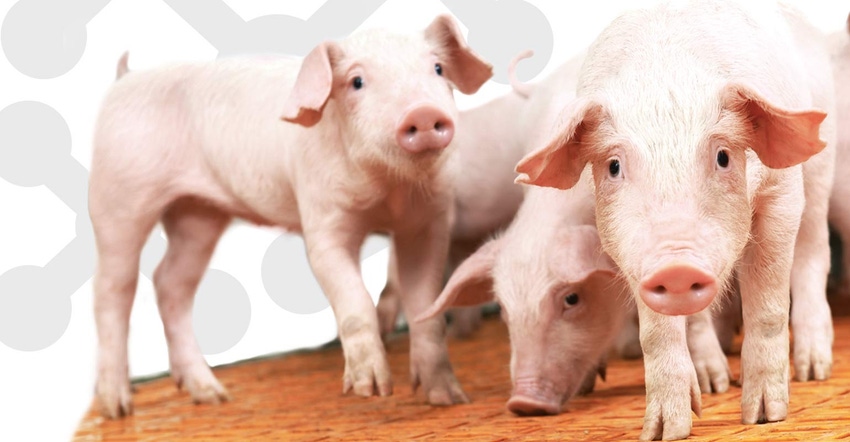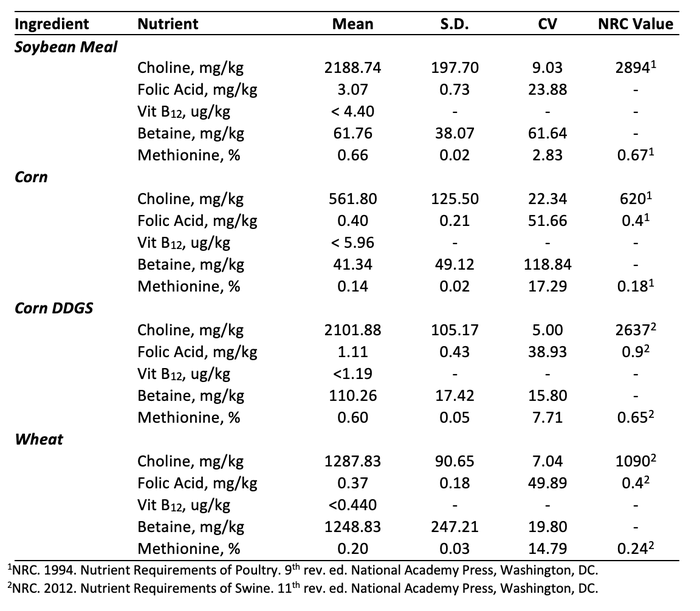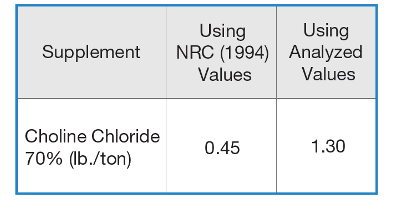Are we severely underfeeding methyl donors when balancing poultry and swine diets?
Research finds large variation between NRC and current commodity nutrient levels
August 25, 2021

Sponsored Content
By Dr. Zack Lowman, Monogastric Technical Services Manager, Balchem Animal Nutrition & Health
Choline and water-soluble vitamins are essential nutrients for all monogastric species. Choline specifically acts as a biochemical building block involved in cell structure and function, making it an influential nutrient for optimum performance and growth. Choline also plays a larger and more crucial metabolic role, impacting at least five major functions within the body:
Precursor to the neurotransmitter acetylcholine; acetylcholine controls virtually all major systems and muscle movements within the body ranging from cardiac function to the central nervous system
Major player in fat metabolism and prevention of fatty liver
Crucial component for building and maintaining cell structure
Source of osmolytes for regulation of cell volume
Source for labile methyl groups for the formation of methionine and important in DNA methylation, along with methionine (Met), betaine, folic acid and vitamin B12.
Deficiencies in any of the methyl donor categories can severely limit bird productivity and efficiency.
To accurately formulate diets to optimize growth and health of any animal species, updated nutrient profiles for all feedstuffs are required. Unfortunately, the most recent data related to choline content and other methyl-containing compounds in various feedstuffs comes from the Poultry NRC (1994) published over two decades ago as well as the Swine NRC (2012) which is slightly more recent. Since then, there have been many scientific advances in the agriculture industry that have not only enhanced our understanding of the essential metabolic roles of choline, but also directly altered the concentrations of choline in feedstuffs commonly used in the livestock sector. These advances include improvements in analytical testing procedures, changes to the genetic makeup of crops, and current processing methods of feedstuffs. Collectively, these changes have led to a need to better characterize and document the nutrient components of current feedstuffs.
Two recent research studies, presented at PSA 2019 and ASAS 2021, showed the nutrient concentration of corn, soybean meal (SBM), dried distillers grains with solubles (corn DDGS) and wheat. The purpose of the research was to sample and analyze numerous feedstuffs for choline and other methyl-containing compound concentrations to build an updated nutrient library.
In 2018, 27 SBM samples and 22 corn samples were randomly collected from numerous states across the United States. An additional SBM sample was collected from each of two international countries (Canada and Hungary). In 2019, 32 corn DDGS samples and 23 wheat samples were also randomly collected from multiple states across the United States. Samples were then analyzed at Eurofins Scientific (Des Moines, Iowa) for choline, betaine, folic acid, and vitamin B12 concentrations.
Results
The results from the methyl compound analysis, as well as data reported by the Poultry and Swine NRC (1994, 2012) for each of the four ingredients, is listed in Table 1. Of these nutrients analyzed, the Poultry and Swine NRC has published only choline and methionine values for SBM, and only choline, folic acid, and methionine values for corn, corn DDGS and wheat.
Analyzed choline levels were 24% lower for SBM, 9% lower for corn and 20% lower for corn DDGS than those reported by the NRC. However, analyzed choline content in wheat was 18% higher than that reported in the NRC. Of the four ingredients tested, corn exhibited the lowest analyzed choline concentration and had the greatest amount of variation between samples with a coefficient of variation (CV) of 22.34.
Vitamin B12 concentrations in all the ingredients were low and below detection limits. Methionine content of SBM was numerically similar to those reported by the NRC; however, the analyzed methionine content of corn, corn DDGS and wheat was determined to be 22%, 8% and 17% lower than that reported by the NRC, respectively. Betaine concentration was variable within and across ingredients with wheat having the highest concentration and corn having the lowest and most variable concentration.
Table 1. Analyzed methyl-containing nutrient concentrations in soybean meal, corn, corn dried distillers grains with solubles and wheat.

Table 2 compares the supplementation rates needed to meet dietary choline requirements when NRC book values and analyzed values are used to formulate a typical (corn/soy-based) broiler starter diet.
Table 2. Choline chloride supplementation rates required when using NRC and actual values for soybean meal.

Accurately characterizing the choline content in commodities has important implications. Improvements in analytical testing procedures, changes to the genetic makeup of crops and current processing methods may collectively influence nutrient concentrations in feedstuffs. Using the Poultry and Swine NRC (1994, 2012) values to formulate for choline could cause a gross under-supplementation in most diets. This discrepancy, coupled with a potentially greater choline requirement needed to meet today’s genetically superior production animals, could seriously compromise productivity and producer profitability.
References
Berry, E.P., C.W. Carrick, R.E. Roberts, and S.M. Hague. 1943. A deficiency of available choline in soybean oil and soybean oil meal. Poultry Sci. 22:442-445.
Leeson, S. and J.D. Summers. 2001. Nutrition of the Chicken 4th Edition. University Books, Guelph, Ontario, Canada.
Molitoris, B.A., and D.H. Baker. 1976. Assessment of the quantity of biologically available choline in soybean meal. J. Anim. Sci. 42:481-489.
NRC. 1994. Nutrient Requirements of Poultry 9th rev. ed. National Academy Press, Washington, DC.
NRC. 2012. Nutrient Requirements of Swine. 11th rev. ed. National Academy Press, Washington, DC.
Zeisel, S.H. 2012. A brief history of choline. Ann. Nutr. Metab. 61(3):254-258.
Zuidhof, M.J., B.L. Schneider, V.L. Carney, D.R. Korver, and F.E. Robinson. 2014. Growth,efficiency, and yield of commercial broilers from 1957, 1978, and 2005. Poultry Science. 93(12):2970-2982.
About the Author(s)
You May Also Like



